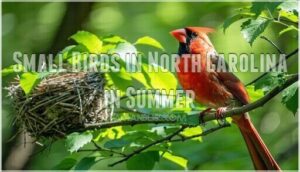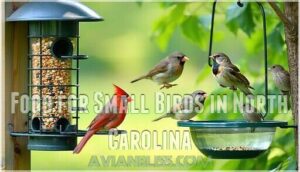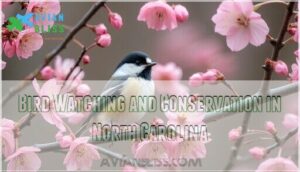This site is supported by our readers. We may earn a commission, at no cost to you, if you purchase through links.

Common residents include the Carolina Chickadee, Tufted Titmouse, and White-breasted Nuthatch that visit feeders daily.
During winter, you’ll spot Dark-eyed Juncos and Ruby-crowned Kinglets, while summer brings Indigo Buntings and various warblers.
These feathered neighbors thrive in North Carolina’s diverse habitats, from mountain forests to coastal plains.
Each species has distinct markings, calls, and feeding preferences that make identification straightforward once you know what to look for, and understanding their seasonal patterns and preferred food sources is key.
Table Of Contents
- Key Takeaways
- Small Birds in North Carolina
- Common Small Birds in North Carolina
- Small Birds in North Carolina in Winter
- Small Birds in North Carolina in Summer
- Other Small Birds in North Carolina
- Identification of Small Birds in North Carolina
- Attracting Small Birds to Your Feeder
- Food for Small Birds in North Carolina
- Bird Feeder Types for Small Birds in North Carolina
- Bird Watching and Conservation in North Carolina
- Frequently Asked Questions (FAQs)
- What birds live in North Carolina?
- Are there brown birds in North Carolina?
- What is the smallest bird in North Carolina?
- What is the state bird of North Carolina?
- Are there bluebirds in North Carolina?
- Do birders love North Carolina?
- What is the smallest bird species found in North Carolina?
- What is the most common small bird in North Carolina?
- Are all small birds in North Carolina migratory?
- What can I do to attract small birds to my backyard in North Carolina?
- Conclusion
Key Takeaways
- You’ll find over 30 species of small birds in North Carolina year-round, including permanent residents like Carolina Chickadees and seasonal visitors like Dark-eyed Juncos in winter and Indigo Buntings in summer.
- You can attract small birds to your backyard by offering black oil sunflower seeds, nyjer seeds, and suet in tube feeders while providing fresh water sources and native plants for shelter.
- You’ll identify small birds more easily by observing their plumage variations, listening to their unique songs, noting their preferred habitats, and watching their feeding behaviors and flight patterns.
- You’re contributing to important conservation efforts when you participate in citizen science projects like bird counts, as North American bird populations have declined 30% since 1970 and need monitoring data.
Small Birds in North Carolina
North Carolina’s small birds showcase remarkable Habitat Diversity, thriving everywhere from dense forests to your backyard feeders.
You’ll discover 31 species of small nc birds throughout the state, each displaying unique Plumage Variations that make bird identification nc both challenging and rewarding.
Bird Migration patterns bring seasonal visitors while year-round residents like Carolina Wrens fill your Backyard Habitats with distinctive Bird Songs.
Whether you’re spotting common birds nc or rare vagrants, these backyard birds nc offer endless opportunities for observation and photography in diverse ecosystems across the state.
Many birdwatchers find success when they focus on size to identify species.
Common Small Birds in North Carolina
Several backyard birds nc species call the state home year-round, making identification easier for bird watchers.
These common birds nc include the bright red Northern Cardinal, melodic Carolina Wren, and cheerful Eastern Bluebird.
Each species shows distinct plumage variations and unique vocalizations that help with bird identification nc.
You’ll find these small nc birds across different habitats, from wooded areas to suburban gardens, each with specific diet preferences and nesting habits that reflect the state’s habitat diversity.
With over 460, North Carolina boasts recorded bird species.
- Northern Cardinal: Males display brilliant red plumage while females show warm brown coloring with red highlights
- Carolina Wren: Known for their loud "teakettle" song and preference for dense vegetation and wooded areas
- Eastern Bluebird: Males feature striking blue upperparts with reddish underparts, preferring grassy areas with nesting boxes
Small Birds in North Carolina in Winter
Watching winter birds in North Carolina reveals nature’s remarkable adaptability.
Winter transforms ordinary backyards into bustling wildlife sanctuaries where small birds showcase their incredible survival instincts.
Twenty-five species call the state home during cold months, transforming your backyard into a wildlife theater.
Winter feeding becomes essential as natural food sources dwindle—cardinals, chickadees, and white-throated sparrows depend on your feeders for survival.
Cold weather survival strategies include plumage changes that provide better insulation.
Migration patterns shift dramatically, with some species moving south while others arrive from northern regions.
Winter habitats offer unique bird identification opportunities when leafless trees expose hidden visitors.
Birders can participate in the Christmas Bird Count during this season.
Small Birds in North Carolina in Summer
Summer transforms North Carolina into a bustling aviary where small birds thrive in warm weather conditions.
During breeding season, you’ll witness increased activity as birds establish territories and raise their young. As northbound migrants depart, birders should carefully observe summer bird activity to spot remaining birds.
Here are five key summer bird behaviors you can observe:
- Breeding Season courtship – Males display vibrant plumage and perform elaborate songs to attract mates
- Nesting Habits – Birds construct intricate nests using twigs, moss, and other natural materials
- Summer Diet shifts – Adults feed protein-rich insects to growing juvenile birds
- Territory defense – Birds become more vocal and aggressive protecting their nesting areas
- Summer Habitats expansion – Species explore diverse ecosystems from forests to gardens for ideal breeding conditions
Other Small Birds in North Carolina
Beyond the familiar backyard visitors, North Carolina harbors fascinating Rare NC Birds that’ll make your birding adventures unforgettable.
Discover North Carolina’s hidden avian treasures beyond your backyard – rare species await your binoculars.
Coastal Birding reveals tiny terns and plovers dancing along shorelines, while Mountain Species like the elusive Cerulean Warbler inhabit high elevations.
Wetland Birds such as marsh wrens hide among cattails, and various NC bird species thrive in Upland Habitats throughout piedmont regions.
These small birds represent North Carolina’s incredible diversity—from pine-loving warblers to secretive swamp dwellers. Many of these, like the Yellow Warbler, are long-distance migrants.
Your bird guide becomes essential when exploring these specialized environments where uncommon species await discovery.
Identification of Small Birds in North Carolina
Identifying nc bird species requires keen observation skills and the right approach. North Carolina’s small birds show remarkable diversity in appearance and behavior, making identification both challenging and rewarding for birders.
Here are five key identification techniques for small birds:
- Plumage variations – Note distinctive colors, patterns, and seasonal changes in feather appearance
- Bird songs – Listen for unique calls, whistles, and melodic patterns each species produces
- Habitat clues – Observe preferred environments like forests, grasslands, or urban areas
- Behavior patterns – Watch feeding habits, flight styles, and social interactions
- Regional differences – Consider geographic location within North Carolina when identifying species
This small bird guide helps you identify small birds systematically using multiple field marks for accurate species recognition. Many birders start by learning about common backyard birds.
Attracting Small Birds to Your Feeder
Creating a backyard haven for north carolina birds starts with smart feeder placement near natural shelter but away from windows.
Your small bird guide success depends on offering diverse seed variety like black oil sunflower seeds and nyjer to identify small birds visiting your yard.
Install a reliable water source nearby to double your attraction power.
Bird feeders nc residents love require regular feeder hygiene – clean weekly to prevent disease.
Use predator deterrents like caged feeders to protect smaller species from bullies while maintaining a consistent feeding schedule.
To further enhance your efforts, consider how to maintain feeder hygiene for a healthier bird population.
Food for Small Birds in North Carolina
You’ll want to stock up on the right foods to keep North Carolina’s small birds coming back for more. Understanding seed preferences and natural forage patterns helps you create an irresistible buffet. Winter feeding becomes especially critical when natural food sources disappear.
Here’s what works best for bird feeding success:
- Black oil sunflower seeds – Cardinals and chickadees can’t resist these protein-packed favorites
- White proso millet – Ground-feeding sparrows and juncos love this small grain
- Suet cakes – High-fat energy for woodpeckers and nuthatches during cold months
- Nyjer seeds – Goldfinches and siskins flock to these tiny black seeds
- Peanut hearts – Wrens and titmice go crazy for these protein-rich morsels
- Fresh water sources – Often overlooked but essential for drinking and bathing
Focus on quality bird seeds rather than cheap filler mixes. Caged tube feeders are especially useful for keeping larger birds away from food intended for smaller species. Insect consumption remains essential, so consider planting native flowers that attract bugs naturally. Your bird feeders NC setup should offer variety while avoiding corn and wheat that attract unwanted visitors.
Bird Feeder Types for Small Birds in North Carolina
Now that you know what small birds eat, choosing the right bird feeder becomes your next adventure in North Carolina.
The wrong feeder can turn your backyard into a disappointment, while the perfect setup creates a thriving bird paradise.
Here are four feeder types that’ll transform your yard into small bird heaven:
- Tube Feeders – These narrow champions with tiny perches keep larger birds away while welcoming chickadees, finches, and goldfinches to feast on sunflower seeds and nyjer.
- Platform Feeders – Open designs let multiple small birds dine together, perfect for sparrows and juncos who prefer ground-style feeding.
- Mesh Feeders – Specialized for nyjer seeds, these prevent larger birds from monopolizing your bird seeds through uncomfortable feeding positions.
- Suet Feeders – Compact winter lifesavers that attract woodpeckers and wrens with high-energy nutrition.
Feeder Placement matters tremendously – position them near bushes for quick escapes but away from predator hiding spots.
Squirrel-proof feeders become essential in areas with high squirrel activity.
Quality Feeder Materials withstand North Carolina’s weather while regular Feeder Maintenance prevents disease.
Mix up your Seed Variety across different bird feeders to attract diverse small birds year-round.
Bird Watching and Conservation in North Carolina
Beyond setting up feeders, you’re stepping into North Carolina’s thriving birdwatching community where every observation counts toward conservation.
The state hosts over 470 bird species, but populations have dropped 30% since 1970 across North America. That’s where you come in.
Audubon Society leads five strategic conservation initiatives while volunteers power the North Carolina Bird Atlas through citizen science. Your backyard sightings contribute to species monitoring efforts that protect 96 critical habitat sites covering nearly 4.9 million acres.
Citizen science projects provide data for tracking bird populations.
Activity Why It Matters What You’ll Discover
NC bird conservation faces real challenges, but habitat preservation efforts rely on everyday bird watchers like you. Join the $75 billion wildlife watching community making a difference.
Frequently Asked Questions (FAQs)
What birds live in North Carolina?
North Carolina’s skies showcase nature’s diversity like a living kaleidoscope.
You’ll spot 31 small bird species year-round, including Carolina Wrens, Ruby-throated Hummingbirds, and Eastern Bluebirds across forests, backyards, and grasslands throughout the state.
Are there brown birds in North Carolina?
You’ll find several brown birds throughout North Carolina.
Carolina Wrens display chestnut brown upperparts, while House Wrens sport light brown plumage.
Female cardinals show buff-brown coloring, and Song Sparrows feature brown-streaked patterns year-round.
What is the smallest bird in North Carolina?
Back in colonial times, you’d marvel at the Ruby-throated Hummingbird, weighing just 1 ounces.
This tiny jewel’s North Carolina’s smallest bird, flitting through your garden like a feathered fairy before heading to Central America for winter.
What is the state bird of North Carolina?
You’ll spot the Northern Cardinal as North Carolina’s official state bird.
Males display brilliant crimson red plumage while females show beautiful buff-brown coloring with reddish accents throughout their feathers and wings.
Are there bluebirds in North Carolina?
Yes, you’ll find Eastern Bluebirds throughout North Carolina year-round.
They have blue upperparts and reddish undersides on males, while females show grayer coloring with blue hints.
They prefer open grassy areas.
Do birders love North Carolina?
Birders absolutely adore North Carolina.
You’ll find incredible diversity here with 31 small bird species alone.
The state’s varied habitats, from mountains to coast, create perfect conditions for year-round residents and seasonal migrants alike.
What is the smallest bird species found in North Carolina?
Weighing barely more than a paperclip, you’ll find the Ruby-throated Hummingbird as North Carolina’s tiniest bird at just 1 ounces.
These miniature marvels migrate thousands of miles to Central America each winter.
What is the most common small bird in North Carolina?
You’ll likely encounter the Carolina Wren most frequently in North Carolina.
This small, energetic bird with chestnut-brown feathers stays year-round, singing its distinctive "teakettle" song from dense vegetation and wooded areas throughout the state.
Are all small birds in North Carolina migratory?
Not all small birds in North Carolina are migratory.
You’ll find year-round residents like Carolina Wrens, Cardinals, and Chickadees alongside seasonal visitors.
Such as Ruby-throated Hummingbirds and warblers that migrate south.
What can I do to attract small birds to my backyard in North Carolina?
You’ll attract Carolina wrens, cardinals, and chickadees by offering sunflower seeds, peanuts, and suet feeders.
Plant native shrubs for nesting spots, provide fresh water sources, and maintain dense vegetation areas where these small birds feel safe.
Conclusion
Last spring, backyard birder Sarah Jones in Asheville identified twelve different species at her feeder in just one morning.
You’ll achieve similar success by applying the identification tips and feeding strategies outlined in this guide.
Small birds in North Carolina offer year-round entertainment and learning opportunities right outside your window.
Start with nyjer seed and suet feeders, then expand your setup as you discover which species visit your yard most frequently.
Happy birding awaits you.
- https://www.birdadvisors.com/small-birds-north-carolina/
- https://www.hummingbirdsplus.org/nature-blog-network/a-guide-to-30-small-birds-commonly-spotted-in-north-carolina/
- https://birdsofjoy.com/small-birds-in-north-carolina/
- https://ownyardlife.com/39-types-of-north-carolina-birds-pictures-and-identification/
- https://avianadmirer.com/blogs/north-carolina-birds-identification/










